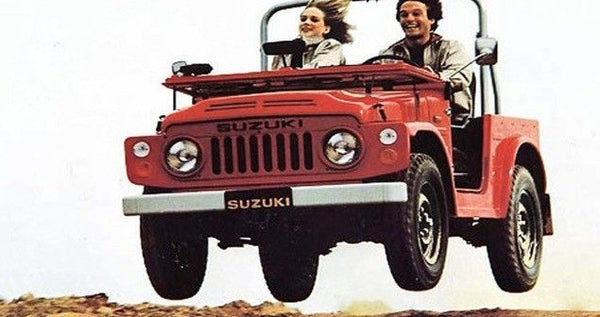
The rich and varied history of small Suzuki 4x4s Down Under!
If you've seen the NEW EPISODE of Mighty Car Mods you'll have seen the boys have expanded their automotive tastes once more, with a Kei 4x4 joining the fleet. Some people might not realise what a rich history the tiny Japanese 4x4s have, dating back 50 years!

Suzuki's small 4x4's roots go all the way back to the late 1960s, starting with the ON360 model from defunct Japanese manufacturer Hope Motor Company. It was after Suzuki purchased HMC that work began on a model coded LJ10, LJ standing for Light Jeep.

Anyone who has clapped their peepers on one of these vehicles can instantly see the similarities to the famous American Willys Jeep and Suzuki's early 4x4 models. Powered by a 359cc air-cooled two-stroke two-cylinder motor, they didn't have quite the same pep as the Yankee model, but they quickly gained a reputation for rugged off-road abilities.
With 25hp the LJ10 Jimny wasn't a tar-burning performance monster but it was the first Kei-class 4x4 and it proved highly capable in tricky off-road conditions.

The 1975 LJ50 was the first model we saw in Australia, with a liquid-cooled 539cc two-stroke three-cylinder under its stumpy bonnet providing enough grunt to get you places faster than walking. Slightly.

Interestingly, there has been a strong Old Wive's Tale connected to Suzuki's evergreen 4x4, where some people feel the name "Jimny" is a misappropriation of "Jiminy" from the Jiminy Cricket character of the classic story Pinocchio.
Suzuki themselves deny this, and have suggsted it is an amalgamation of "Jeep" and "Mini", two very popular Western models at the time of the Jimny's 1970 introduction. It also pays to remember this is a country famous for naming cars things like, "Mitsubishi Delica Active Urban Sandal" and "Nissan Harmonized Big Thumb", so clearly anything goes.

After 11 highly successful years, Suzuki released a new-generation model Jimny in 1981 that was available with a 550cc or 660cc three-banger engine. It was sold in worldwide markets under a huge array of names, including Chevrolet Samurai, Holden Drover, Maruti Gypsy, Santana Samurai, Suzuki Caribian, Suzuki Katana, Suzuki Protohar, Suzuki SJ410, Suzuki SJ413, Suzuki Samurai, Suzuki Santana, Suzuki Sierra, and Suzuki Fox.

Offered as a smaller, more efficient version of hugely popular full-size open-top off-roaders like the Chevy Blazer, Ford Bronco, and Dodge Ramcharger, the Samurai helped popularise the Suzuki brand in America beyond their reputation as a successful motorbike manufacturer.

The second-generation Jimny hung around for an incredible 17 year run, being replaced in 1998 with a third-generation update. Importantly, while other small 4x4s had ditched low-range transmissions and other equipment needed for proper off-roading, the tiny Suzuki kept all this hardware and so made it beloved among outdoors types.
This was the first time the Jimny name was seen in Australia, and it could be had with a range of non-Kei-class engines. On top of the 658cc three-pot offered in Japan, there was a 1298cc JB33 in-line four, a 1328cc M13A in-line four, and a 1461cc JB53 diesel four-banger available.

Some 20 years after the third-generation Jimny went on sale, Suzuki released the current, fourth-generation model to rapturous applause as it retained many of the key features the market wanted; small size, minimal overhangs, quirky styling and rugged engineering.


![Limited Edition Car Poster [AUTOGRAPHED]](http://mightycarmods.com/cdn/shop/files/ONLY_45AUD_480x480.png?v=1765858723)


